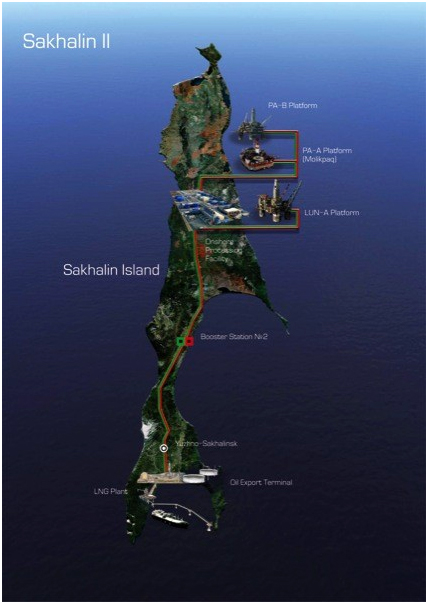Sakhalin 2
 Sakhalin 2, Phase II Pipelines Project for Sakhalin Energy Investment Company (SEIC) was an extremely complex and challenging project on several levels, including political, environmental, cultural, regulatory, topography, geophysical, and weather.
Sakhalin 2, Phase II Pipelines Project for Sakhalin Energy Investment Company (SEIC) was an extremely complex and challenging project on several levels, including political, environmental, cultural, regulatory, topography, geophysical, and weather.
The onshore oil and gas pipelines ran from Piltun in the north of Sakhalin Island via the Onshore Processing Facility (OPF), near Lunskoye, to Prigorodnoye, in the south. The two pipeline systems each cover a distance of over 800 km, including 126 km of swamp crossings, 110 km over mountainous routes, more than 1,000, mainly small but sensitive, river crossings, 18 rail crossings, 10 road crossings, and 21 seismic fault crossings. The distance from the Piltun landfall to the OPF is 172 km (pipeline diameters in this part of the route are 20-inch diameter for both the oil and the gas line). The distance from the OPF to the Liquefied Natural Gas/Oil Export Terminal (LNG/OET) plant is 637 km (pipeline diameters in this part of the route are 24 and 48 inches for the oil and gas line, respectively). Two Short multiphase pipelines (30-inch diameter, onshore length 7 km) and a 4-inch Mono-Ethelyne Glycol - MEG – pipeline in the same right-of-way connect the landfall at Lunskoye to the OPF. The scope included a gas distribution terminal (GDT) with approximately 18 pigtraps and 160 block valves of various diameters, high voltage electric cables, and fibre optic cables.
Starstroi was awarded the EPC contract and, alongside Saipem, operated as a management contractor but had contractual arrangements with Lukoil and Spiecapag. The pipeline route was divided into 4 sections from north to south 272kms, 175kms, 160kms, and 190kms and construction completed by 7 Russian pipeline subcontractors with a combined workforce totalling over 5,000 workers.
The project was constrained by stringent Russian Federation environmental and industrial regulations, but Russian pipeline construction subcontractors consistently breached these regulations, which was a major challenge for SEIC and its expat supervisory workforce.
I was hired initially as a Company Site Representative to take over spreads 1A and 1B from Chaivo to the OPF. Starstroi and its subcontractors were not complying with project objectives regarding HSE and Quality, and schedule performance was also poor, but with good management, I was able to restore these requirements to a satisfactory level and increase productivity. My management methods aimed at the winter program of river crossings were highly appreciated and adopted by the other sections. When the contract changed from EPC to Cost reimbursable in 2006, I was transferred to Section 4 and took over running of the subcontractor as Construction Manager. I developed a good working relationship with the Russian pipeline construction subcontractor. I quickly gained their respect, and within a short period, they adopted a cooperative attitude to performing the work according to the terms and the spirit of their contract.






